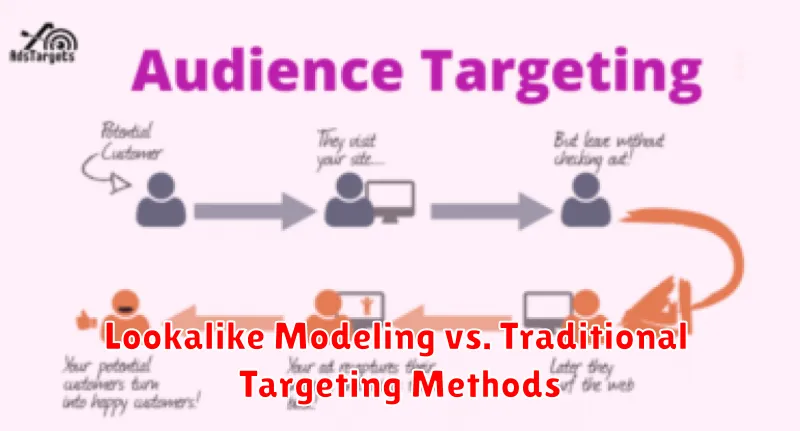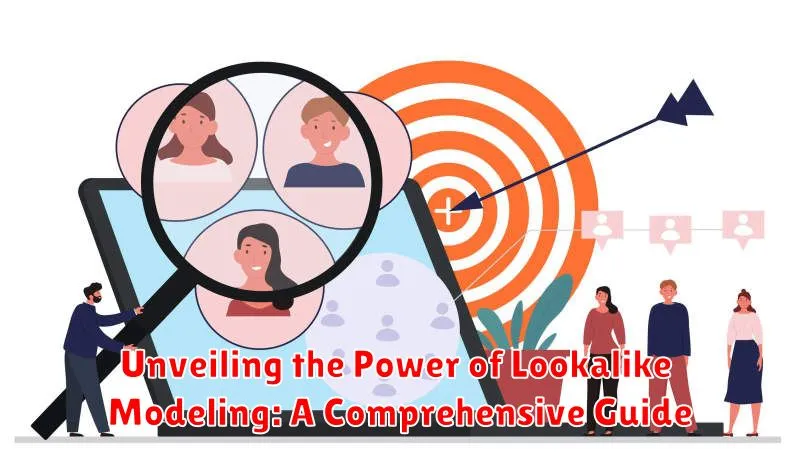In today’s increasingly competitive digital landscape, reaching the right audience is paramount for success. Traditional marketing methods often fall short, leading to wasted resources and suboptimal results. This is where the power of lookalike modeling comes into play. Lookalike modeling, a sophisticated audience targeting technique, allows businesses to identify and engage with potential customers who share similar characteristics and behaviors with their existing, high-value customer base. This comprehensive guide aims to unveil the power of this strategy, providing a deep dive into its mechanics and practical applications.
This article will serve as your definitive resource for understanding and implementing lookalike modeling effectively. We will explore the underlying principles, discuss various data sources and algorithms involved, and provide step-by-step instructions on how to create and refine your lookalike audiences. Furthermore, we will delve into real-world examples and case studies demonstrating the tangible benefits of lookalike modeling across different industries. Whether you are a seasoned marketing professional or just starting to explore the world of audience targeting, this guide will equip you with the knowledge and tools necessary to harness the immense potential of lookalike modeling and optimize your marketing campaigns for maximum impact.
What is Lookalike Modeling and How Does It Work?
Lookalike modeling is a powerful targeting technique used in marketing to identify new potential customers who share similar characteristics with your existing, high-value customer base. It allows marketers to extend their reach beyond traditional demographic or interest-based targeting.
The process typically involves these steps:
- Seed Audience Creation: You provide a seed audience, a list of your best customers (e.g., website visitors, purchasers, email subscribers). The larger and higher quality this seed audience, the better the model will perform.
- Data Analysis: The lookalike modeling algorithm analyzes the attributes and behaviors of your seed audience, looking for patterns and commonalities.
- Profile Creation: The algorithm builds a profile of the ideal customer based on the identified patterns.
- Audience Expansion: The algorithm then scans a larger pool of potential customers and identifies individuals who closely match the established profile.
- Targeting: The resulting “lookalike audience” is then used to target advertising and marketing campaigns.
Effectively, lookalike modeling leverages data-driven insights to find new customers who are statistically more likely to be interested in your products or services.
The Core Components of Lookalike Modeling
Lookalike modeling hinges on several crucial elements working in concert to identify and target new, high-potential customers. Understanding these components is essential for creating effective lookalike audiences.
The first, and perhaps most important, component is the seed audience. This is your source data – a group of individuals who have already demonstrated valuable behavior, such as making a purchase, signing up for a newsletter, or engaging with your content. The quality and relevance of the seed audience directly impacts the performance of the lookalike model.
Next is the algorithm or machine learning model itself. These algorithms analyze the attributes and characteristics of your seed audience to identify patterns and similarities. Different platforms offer varying algorithms, each with its own strengths and weaknesses. The algorithm uses these patterns to find users who share similar traits but are not currently part of your known customer base.
Finally, platform data plays a significant role. The algorithm relies on the platform’s vast database of user data, including demographics, interests, behaviors, and online activities, to identify potential lookalikes. The breadth and accuracy of this data influence the effectiveness of the modeling process.
Benefits of Using Lookalike Modeling in Your Marketing Campaigns
Lookalike modeling offers several significant advantages for marketing campaigns, leading to improved efficiency and return on investment. By leveraging existing customer data, businesses can identify and target new prospects who share similar characteristics with their most valuable customers.
One key benefit is enhanced targeting precision. Instead of relying on broad demographic or interest-based targeting, lookalike models pinpoint individuals who are highly likely to convert, resulting in a more focused and effective campaign.
Another advantage is increased reach. Lookalike modeling allows you to expand your audience beyond your existing customer base, reaching potential customers who might not have been discovered through traditional targeting methods.
Improved conversion rates are also a direct result of using lookalike audiences. Because these audiences are more receptive to your message, they are more likely to engage with your ads and ultimately make a purchase.
Finally, lookalike modeling contributes to reduced customer acquisition costs. By focusing on a high-potential audience, marketers can minimize wasted ad spend and optimize their budget for maximum impact.
Different Types of Lookalike Audiences You Can Create
Lookalike modeling offers various options for creating audiences based on the similarity to your seed audience. Understanding these types allows for refined targeting and campaign optimization. These variations are often determined by the platform you are using (e.g., Facebook, Google Ads), but the core principles remain similar.
Similarity-Based Lookalikes
These prioritize creating an audience that closely resembles your seed audience. This approach is effective when accuracy and relevancy are paramount, even if it means a smaller audience size. Platforms often allow you to adjust the “similarity” percentage, with lower percentages indicating a closer match.
Reach-Based Lookalikes
These prioritize a larger audience size, sacrificing some degree of similarity. While the overall resemblance may be less precise, this approach expands your reach and potential for conversions. This option is preferable when you aim to increase brand awareness or acquire a larger customer base.
Value-Based Lookalikes
These are created using a seed audience based on customer value, such as lifetime purchase amount. The lookalike audience is then comprised of users who are most likely to be high-value customers.
Lookalike Modeling: Best Practices for Optimal Performance
To maximize the effectiveness of your lookalike modeling campaigns, adhere to these best practices. Firstly, regularly refresh your seed audience. Customer behavior changes, so keeping your seed data current ensures the lookalike audience remains relevant.
Secondly, test different lookalike audience sizes. Platforms often allow you to create audiences that are a percentage of the total population. Smaller percentages will be more similar to your seed audience, while larger percentages will reach a broader audience. Experiment to find the optimal balance.
Thirdly, continuously monitor and refine your targeting. While lookalike modeling is powerful, it’s not a “set it and forget it” strategy. Track key metrics like click-through rates (CTR) and conversion rates, and adjust your campaigns as needed. A/B testing different ad creatives and placements can further optimize performance.
Finally, consider segmenting your lookalike audiences based on platform insights or other relevant data points. This allows for more personalized messaging and improved engagement.
How to Choose the Right Seed Audience for Your Lookalike Model
The seed audience is the cornerstone of any successful lookalike modeling campaign. This initial group of individuals provides the data from which the algorithm identifies common characteristics and patterns. Choosing the right seed audience is therefore critical for generating high-quality lookalike audiences that deliver desired results.
Here’s a breakdown of key considerations:
- Size Matters: Aim for a seed audience with at least 1,000 individuals, ideally more. Larger seed audiences provide more data points, leading to more accurate lookalike models.
- High-Value Customers: Prioritize using your best customers as your seed. These are typically individuals who have made multiple purchases, spent a significant amount of money, or demonstrated high engagement with your brand.
- Data Quality is Paramount: Ensure the data associated with your seed audience is accurate and up-to-date. Inaccurate data can skew the model and lead to poor-performing lookalike audiences.
- Representativeness: The seed audience should be representative of your target market. If your target market is diverse, ensure your seed audience reflects that diversity.
By carefully selecting a well-defined and representative seed audience, you significantly increase the likelihood of creating effective lookalike audiences that drive conversions and achieve your marketing objectives.
The Role of Data Quality in Successful Lookalike Modeling
Data quality is paramount to the success of lookalike modeling. The accuracy, completeness, and consistency of your data directly impact the quality of the resulting lookalike audience. Inaccurate or incomplete data within your seed audience can lead to the creation of lookalike audiences that do not accurately reflect your desired target.
Here’s why data quality is crucial:
- Accuracy: Ensures the seed audience truly represents your desired customer profile.
- Completeness: Provides enough information for the algorithm to identify key attributes and patterns.
- Consistency: Prevents conflicting data from skewing the model’s results.
Before implementing lookalike modeling, invest in data cleansing and validation processes. This includes:
- Removing duplicate entries.
- Correcting errors and inconsistencies.
- Filling in missing information (where appropriate and ethically permissible).
By prioritizing data quality, you can significantly improve the performance of your lookalike modeling campaigns and achieve better marketing outcomes.
Lookalike Modeling vs. Traditional Targeting Methods

While both aim to connect with relevant audiences, lookalike modeling and traditional targeting methods differ significantly in their approach. Traditional targeting relies on pre-defined demographics, interests, and behaviors explicitly identified by users. For example, a marketer might target women aged 25-35 interested in fashion.
In contrast, lookalike modeling leverages data science to identify individuals who share similar characteristics with an existing “seed” audience (e.g., past customers, website visitors). The algorithm analyzes numerous data points to find patterns and predict who else is likely to convert or engage. This offers a more nuanced and potentially wider reach compared to rigid, pre-defined segments.
Here’s a brief comparison:
- Traditional Targeting: Based on explicit, self-reported data.
- Lookalike Modeling: Based on implicit data and algorithmic pattern recognition.
- Traditional Targeting: Can be more transparent but potentially less accurate.
- Lookalike Modeling: Can be less transparent but potentially more accurate and scalable.
Ultimately, the best approach depends on campaign goals and available data. Lookalike modeling often outperforms traditional methods when seeking new customers or expanding reach beyond known demographics.
Measuring the Success of Your Lookalike Modeling Campaigns
Assessing the effectiveness of your lookalike modeling campaigns is crucial for optimizing your marketing efforts and maximizing your return on investment. Several key metrics should be closely monitored to determine whether your lookalike audiences are performing as expected.
Here are some important indicators to track:
- Conversion Rate: Measures the percentage of users who complete a desired action (e.g., purchase, sign-up) after interacting with your ad.
- Cost Per Acquisition (CPA): Calculates the cost associated with acquiring a new customer through your lookalike campaign. A lower CPA indicates better efficiency.
- Return on Ad Spend (ROAS): Shows the revenue generated for every dollar spent on advertising. A higher ROAS signifies a more profitable campaign.
- Click-Through Rate (CTR): Tracks the percentage of users who click on your ad after seeing it. A higher CTR suggests that your ad creative and targeting are resonating with the audience.
- Website Traffic: Monitor the volume and quality of traffic driven to your website from your lookalike campaigns.
By regularly analyzing these metrics, you can gain valuable insights into the performance of your lookalike audiences and make data-driven adjustments to your campaigns. Remember to compare the performance of your lookalike audiences with your existing audiences to gauge the true impact of this targeting strategy.
Common Challenges and Pitfalls to Avoid with Lookalike Modeling

While lookalike modeling offers significant advantages, several challenges and pitfalls can hinder its effectiveness. Recognizing and proactively addressing these issues is crucial for maximizing campaign performance.
Data Quality Issues
Poor data quality in your seed audience is a significant risk. Inaccurate or incomplete data can lead to the creation of lookalike audiences that are not truly representative of your ideal customer profile. Therefore, ensure your seed audience data is up-to-date, accurate, and comprehensive.
Over-Reliance on Algorithms
While algorithms are powerful, they are not infallible. Blindly trusting the algorithm without critically evaluating the results can lead to suboptimal outcomes. Regularly monitor campaign performance and adjust parameters as needed.
Small Seed Audience Size
A seed audience that is too small can limit the accuracy and scalability of your lookalike model. Insufficient data points can result in a model that is overfitted and unable to generalize to a larger audience. Aim for a substantial seed audience size to improve model accuracy.
Ignoring Platform-Specific Differences
Different platforms have different algorithms and data sources. What works on one platform may not work on another. Tailor your lookalike modeling strategy to the specific platform you are using.
Lack of Continuous Optimization
Lookalike modeling is not a set-it-and-forget-it strategy. Continuous monitoring and optimization are essential for maintaining performance. Regularly review campaign results and adjust your parameters to adapt to changing market conditions.

